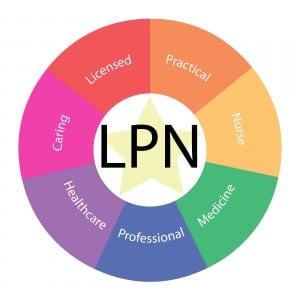
Working as a Licensed Practical Nurse (LPN)

What Does LPN Stand For?
Licensed Practical Nurse (LPN), also known in some states (California and Texas) as Licensed Vocational Nurses (LVNs).
What Do LPNs Do?
What the LPN does depends on the “scope of practice” laws in the state where you work. Each state board of nursing regulates what the LPN can and cannot do. LPNs generally provide patient care in various settings within many clinical specializations under the direction of registered nurses and physicians. LPNs usually:
- Administer oral and intravenous medications
- Chart in the medical record
- Take the patient’s vital signs
- Change wound dressings
- Collect specimens such as blood, urine, sputum, etc
- Insert and care for urinary catheters
- Care for patients with tracheostomy tubes and ventilators
- Insert and care for patients who need nasogastric tubes
- Give feedings through a nasogastric or gastrostomy tube
- Care for ostomies
- Monitor patients for a change in clinical condition
- Call the physician if needed
- Perform CPR in emergencies
- Are supervised by an RN
Although each state sets the scope of practice for the LPN, each organization can narrow the scope. It is important, therefore, to know what the specific organization does not allow the LPN to do. In some organizations (but not all), the registered nurse (RN), rather than the LPN, is expected to carry out the following tasks:
- Start, monitor, and/or discontinue intravenous catheters or intravenous fluids
- Start, monitor, or change critical intravenous medications that stabilize the heart or blood pressure
- Take phone or verbal orders from the MD
- Administer intravenous medication that is given “push” or very quickly
- Care of central intravenous lines (that go to or near the patient’s heart)
What are an LPN's Duties?
LPN duties often vary depending on the state where they work. Some state regulations allow LPNs to provide medication to patients, while others allow LPNs to administer intravenous drips.
In general, LPNs are responsible for assisting registered nurses and doctors by providing basic medical care to their patients. Some of the typical job duties performed by LPNs include:
- Changing bandages, catheters, or IVs
- Checking vital signs like blood pressure and pulse rates
- Feeding and assisting patients who are unable to do so themselves
- Keeping detailed records of patients’ overall health
- Reporting any changes in patients’ health to doctors and nurses
These are just a few of the standard duties LPNs perform, and their day-to-day routines may vary depending on the needs of the hospitals, physician’s offices, or nursing homes where they work.
Additional duties of LPNs include:
- Greeting Patients and Recording Their Information
LPNs are often the first point of contact a hospital, doctor’s office or other healthcare clinic has with patients. After patients are called back to be seen by a doctor, LPNs record their medical history, known allergies, height, weight, internal body temperature, blood pressure, pulse, and breathing rate. These signs give doctors and registered nurses a good indication of patients’ overall health before any additional tests are administered.
- Collecting Samples
One of the most important day-to-day responsibilities for LPNs is collecting patient samples for routine laboratory testing, such as urine, feces, saliva, and other bodily fluids. In addition, some LPNs are trained to draw blood to test for certain diseases and infections.
- Monitoring Patients’ Health
Registered nurses and doctors may need to see several dozen patients in a single day.
Because of those demands, LPNs are asked to monitor their patients’ health throughout their shifts. Close monitoring is especially important after major surgeries, accidents, and when patients have received new medications. LPNs are trained to quickly identify adverse reactions or complications and notify doctors and registered nurses immediately.
- Counseling Patients and their Families
LPNs are often tasked with providing a human touch to routine healthcare. They often teach patients and their family members how to administer medication, which symptoms to be aware of after the patient goes home, which activities to avoid, and how to adopt and maintain a healthy lifestyle. Read more about what LPNs do.

Where Do LPNs Work?
The U.S. Bureau of Labor Statistics estimates that LPNs were employed in roughly 655,000 jobs in 2022. These nurses worked in a variety of settings, including:
- Elementary schools, middle schools, and high schools
- Home healthcare organizations
- Nursing homes and long-term care facilities
- Physicians’ offices and other private practices
- State, federal, and private hospitals
- Universities
In addition, LPNs can find work in other settings as missionaries, serving in the military, or as consultants for healthcare companies. Other nurses use their patient care knowledge and familiarity with healthcare settings by working as medical coders, billers, transcriptionists, and customer service representatives. Evaluate the many potential practical nursing careers.
LPN Work Settings
The most common places that an LPN works include but are not limited to:
- Hospital - The hospital setting provides care to patients who are acutely ill or have just had major surgery. The LPN will work under the supervision of an RN caring for patients. Most community hospitals hire LPNs. However, it is the larger teaching hospitals that have or wish to acquire “magnet status” from The Joint Commission (the accreditation organization for hospitals) that do not hire LPNs. The work schedule depends upon the facility but usually consists of 12-hour shifts with every other weekend off and rotating shifts.
- Rehabilitation Centers – The rehabilitation setting provides care to patients in the process of regaining skills after a recent medical or surgical event. Patients work on their recovery in these settings with the help of physical, occupational, and speech therapists. The LPN and RN work side-by-side in caring for patients. For example, a patient may have received a hip replacement in the hospital but still needs to gain muscle strength, crutch walking skills, and practice walking on different surfaces. The patient can transfer to a rehabilitation setting to accomplish those goals. The work schedule in this setting depends upon the facility but usually requires 12-hour shifts with every other weekend off and rotating shifts.
- Nursing Home – This setting provides care to patients that are not expected to improve and may be there for very long periods of time. The LPN may be in charge of patient care in this setting. As an example, a stroke patient may be in the hospital initially after a stroke. After being stabilized, they move to a rehabilitation center to work on regaining speech and movement skills. However, once the patient’s progress has plateaued, and if there is insufficient support for care in the home, the patient may be transferred to a long-term care facility or nursing home. The work schedule depends upon the facility but usually consists of 12-hour shifts, rotating shifts, and every other weekend off. Some long-term care facilities opt for 8-hour shifts.
- Home Care - Many patients can live in their homes or a family member’s home with the support of additional health care providers. The type of care provided in the home depends on what the patient needs. Some complex patients need LPN care for several hours per day so that the family can sleep. Some patients need LPN oversight to ensure the medical plan continues at home and provide patient education. The shift hours worked depend on the hours needed per day or week. The episodic visit may last from 1 -2 hours.
- Medical Office or Urgent Care Clinic - This setting provides office visits for patients to see their healthcare provider, usually for a well-care checkup. The LPN can assist by taking important patient vital signs, medication history, and weight and following up with necessary tests that may be ordered after the visit. The LPN's hours will depend on what times and days the office is open to patients. There may be occasional weekends.
- School – Students in the school setting often require episodic care for minor illnesses such as lice, sore throats, or vomiting. Elementary schools, high schools, and colleges may hire an RN or LPN to provide this care. If the student is younger, a parent picks them up from school to take home. If the student is in college, care is provided until the student can safely drive or walk home unless emergency care in a hospital is needed. The work hours depend upon when the school is open and students are on site.
LPN Areas of Practice
There are some very exciting areas of nursing practice from which the LPN can choose to work. Each area is very unique – as is every LPN! It is a great idea to work in many areas of nursing over time to increase your “marketability.” Read about 8 roles of the LPN and the various LPN careers.
- Pediatrics – This area of nursing care specializes in sick patients ages newborn
 to age 18.
to age 18.
- Labor and Delivery - Nursing in this specialization involves caring for pregnant women just before, during, and after the delivery of a baby, as well as caring for the newborn.
- Neonatal – Neonatal unit nurses care for sick newborns and premature infants just after delivery.
- Oncology – Patients needing an oncology nurse usually have one of the many forms of cancer. Oncology nurses administer chemotherapy, help treat pain and nausea, and assist with procedures.
- Neuro ICU – The nurse in Neuro ICU cares for patients after brain surgery or severe head injuries. They specialize in the neurological assessment of patients and know how to monitor the patient for improvement or deterioration.
- Trauma ICU - The Trauma ICU nurse cares for patients after an accident of some type. This can be a car accident, motorcycle accident, or building collapse—anytime multiple systems are involved with injury.
- Burn Unit – When a patient is burned over a large percentage of the body, burn nurses are trained in dressing changes, pain management, and monitoring for sepsis – all while working in a team over a period of time as patient healing occurs.
- Cardiac ICU – Patients receive nursing care in a Cardiac ICU after heart surgery.
- Emergency Room – The emergency room nurse cares for patients suddenly unstable from an illness just after an accident. Patients are quickly stabilized and then transferred to an ICU.
- Rehabilitation Nurse – Rehabilitation nursing involves working with physical, occupational, and speech therapists to help the patient regain skills lost due to illness or injury.
- Gerontology Nurse – Nurses specializing in gerontology care for the unique needs of elderly patients.
See what BSN careers are available if you continue furthering your nursing education. Find a practical nursing job now!
Finding Your LPN Job
After you decide which area of practice you want to work in, search out locations where employers offer this type of care. For example, if you want to work in a Burn Unit, it may be necessary to search all the area hospitals to find out which one has a Burn Unit. Burn Units are usually located in a designated Level 3 Trauma Center hospital. Go to that hospital’s website and find their Careers page. Click on the link and search for jobs in your desired practice area. Carefully look at the title to ensure an LPN position is available, and then read the position description, hours and shifts to be worked, and any salary information provided. Compare jobs between facilities and narrow your decision to your favorite job opportunities. Read about the core values of nursing professionals. Click here if interested in finding a position: LPN Jobs.
Completing an LPN Job Application
 Many job applications are submitted online, but some still require hard copies. Before you start, gather a couple of important documents:
Many job applications are submitted online, but some still require hard copies. Before you start, gather a couple of important documents:
- Employment History - You will need the facility's name, address, phone number, supervisor’s name, and direct phone number.
- Education History - Gather the name, address, and phone number of your high school and nursing school. It is a good idea to request an unofficial grade transcript from your LPN school in case your potential employer requests it, although it may not be required.
- License Information - Make sure you know the date you took your LPN exam and in which state. Some employers do not require a copy of your license because Human Resources will do an online check to validate that you have a license in the same state as the place you are applying to work. If you want to work in another state, find out how to transfer your LPN license accordingly.
- Follow Instructions - How you complete this online or paper application says a lot about you. Make sure to proofread for spelling and clarity and use proper grammar. Fill out all the spaces to the best of your ability. Not following instructions can indicate how you would perform with instructions on the job. You want to make a good impression!
- Test Preparation - Many hospitals require a math test before hiring the LPN. Prepare by reviewing simple ratios, IV drip conversions, medication names, and purposes. Ask what the cutoff is for pass/fail. Be careful and thoughtful as you answer the test questions, and be mindful of time (especially if it is a timed test). The test may be part of the online application or something you take when you come in for an interview.
- Submission - Before you turn in the paper application or hit the “submit” button, review all the information again to ensure it is complete. Some employers will not accept incomplete applications.
LPN Interview
If you have been asked to come in for a job interview, there are a few important things to keep in mind. First, do some online research about the organization you are applying to. What type of care do they specialize in, and in what care setting? How many patients do they see on average? Learn as much as you can ahead of time about the job. What is the role's scope of practice within the organization? Wear the appropriate attire for the position and bring a copy of your resume. Practice potential questions and answers with a friend. There are many interview videos available online to help prepare you.
More about interviewing in our LPN Interview Guide. For specific topics, refer to the following:
- Dress for Success
- Interview Timing
- Do Your Homework
- Expect the Unexpected
- 10 Common Interview Questions & Answers
- Practice Makes Perfect
- Say "Thank You"
Starting Work as an LPN
When you agree to a job offer and salary, you will be given a date to start work. It may be necessary to have a pre-employment physical exam done, which can include drug testing. Prepare by purchasing any needed items, such as nursing scrubs or a stethoscope. You will be issued a computer security username and password that will allow you access to timekeeping, medical records, and registration systems. You will need to complete several educational requirements specific to your role and department within the first couple of days of starting in an organization.
LPN Work Orientation Period
The first month or so of work in an organization is your orientation period. The purpose of an orientation period is for the organization to assess if you have the skills needed to do the job and for you to decide if the job is a good fit. Depending upon your role and the setting, your orientation period may last up to 6 weeks. A preceptor or mentor will be assigned to orient you and have you demonstrate competency. At the end of the orientation period, there is usually an evaluation process to get performance feedback from your supervisor.
LPN License Renewal
Once you have obtained your LPN state license for the first time, there will be a date that your license expires. Pay close attention to this date and refer to your state licensure requirements regarding renewing your license. Requirements vary from state to state – some states require only a renewal fee. Other states require proof of additional continuing education credits (the number of hours varies) before renewal is allowed.
LPN Continuing Education Credits
Some State Boards of Nursing require a certain number of continuing education credits (CEUs) to renew your LPN license at the time of expiration. Continuing education credits are accredited videos, articles, lectures, or conferences that provide education to the LPN to assure competency. Each state’s policy differs, so refer to our guide to LPN CEU state requirements or via third-party resource for a list of all states and their continuing education requirements. Read up on more ways to obtain CEUs for LPNs.
Advancing LPN Education Options
-
LPN to RN/BSN Online - Achieve Test Prep

*Must Be a LPN/LVN
LPNs earn your ADN or BSN degree online in up to 1/2 the time and cost of traditional programs. With No Waiting List to get started, Free Books, and Low Cost financing options available, this is the perfect way for LPNs, LVNs, and Paramedics to earn your Associates Degree in Nursing and your RN license. Our convenient, instructor led test-out program allows you to learn at an accelerated pace and earn college credit-by-examination which then is eligible to be transferred to an ACEN accredited nursing school or 100's of universities nationwide.
Related Articles
Featured Article

How to Prepare for Your LPN/LVN Program Entrance Exam




